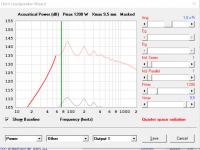Hi Team, I have the pleasure to read a lot of good information here and today I would like to have your help.
I was designing from a lot of time a good kicker for my system. But i tried to read and understand about S1 S2 S3 from hornresp, But I could not be possible for me to calculate how are the size of horn and the box.
Speaker component used is 18LW2400.
Hornresp plan is attached, I will appreciate your help.

I was designing from a lot of time a good kicker for my system. But i tried to read and understand about S1 S2 S3 from hornresp, But I could not be possible for me to calculate how are the size of horn and the box.
Speaker component used is 18LW2400.
Hornresp plan is attached, I will appreciate your help.

Attachments
The volume of the horn and box are given as "System Volume", 214.843 liters.But i tried to read and understand about S1 S2 S3 from hornresp, But I could not be possible for me to calculate how are the size of horn and the box.
The actual size is determined by your folding plan and material thickness.
Con(ical) horns occupy more volume for a given low frequency output than Ex(ponential), and both require expansion in both height and width.
If you are planning to build using two parallel walls, use Par(abolic) and approximate each section of the horn to be equal in area of expansion to an exponential horn.
Probably best to keep the cone area(SD) to horn throat (S1) to ratio no more than 3/1 to keep from bending/kinking/breaking the cone at high power.
Your SD/S1 is 9.42/1, OK for a few watts, but not for full power.
Last edited:
S1, S2, etc. are cross sectional areas. So typically the internal width of the cabinet times the internal height. L12, L23, etc. are the axial distances between those cross sectional areas.
If that picture is somewhat to scale, you'll have a hard time fitting an 18" driver in there (you would have to increase the width). The internal width for a 18" driver is typically around 50 cm.
If that picture is somewhat to scale, you'll have a hard time fitting an 18" driver in there (you would have to increase the width). The internal width for a 18" driver is typically around 50 cm.
The horns length is too short, the expansion is too quick and there is dead spaces that could be better used with a different fold.
This is why the frequency graph is showing this to be a fine looking mid-bass horn.
This is why the frequency graph is showing this to be a fine looking mid-bass horn.
I do not know how large is S1, 470, how can I interpret to centimeters.
S1 = 470 cm^2.
(Move the mouse pointer over the S1 label or input box to display the parameter description in the status bar panel at the bottom of the window).
Suggest you include a throat chamber because S1 < Sd.
Thanks you to all for your advice,
I made some modification and I obtain surprising improvement for me.





Now, I need to think how design a box including throat chamber with these new sizes.
In my mind appear an W-sub or folded horn.
¿Do you recommend included a rear vent in actual closed box?, I made some calculates.


I made some modification and I obtain surprising improvement for me.





Now, I need to think how design a box including throat chamber with these new sizes.
In my mind appear an W-sub or folded horn.
¿Do you recommend included a rear vent in actual closed box?, I made some calculates.


As suggested by Weltersys, you need to go into the segment length fields and change Con Par by using the P key.
Hi Team, I appreaciate a lot of your Advices!. Finally I could get sizes of horn, adding a new part of horn simulating a parabolic horn I obtain a 55 to 150 hertz in flat response subwoofer with 110dB sensibility in quarter space.
Sizes
60cm of weight (aprox the size of speaker and wood spaces 1.8mm). (I need to add this size of wood).
Now the job is to accommodate the measures.



Sizes
60cm of weight (aprox the size of speaker and wood spaces 1.8mm). (I need to add this size of wood).
Now the job is to accommodate the measures.



Last edited:
Hi team, why when I put parabolic horn type, the volume is more accurate in formula V=(1/2*(b1+b2)*Ht)*Hp
For example in horn segment 3:
Internal weight is 56,4
V=(1/2*(b1+b2)*Ht)*Hp
V=(1/2*((S3/56,4)+(S4/56,4)* L34 * internal weight ))
380000=1/2(28,36879433+106,3829787)* 100 * 56,4

in compare with Conical horn type.


Numbers:




For example in horn segment 3:
Internal weight is 56,4
V=(1/2*(b1+b2)*Ht)*Hp
V=(1/2*((S3/56,4)+(S4/56,4)* L34 * internal weight ))
380000=1/2(28,36879433+106,3829787)* 100 * 56,4

in compare with Conical horn type.


Numbers:




Last edited:
- Status
- Not open for further replies.
- Home
- Loudspeakers
- Subwoofers
- Kicker DIY subwoofer (design)











